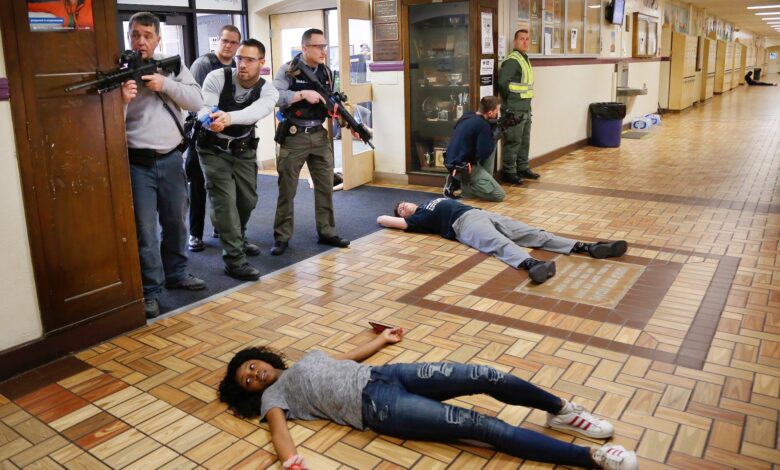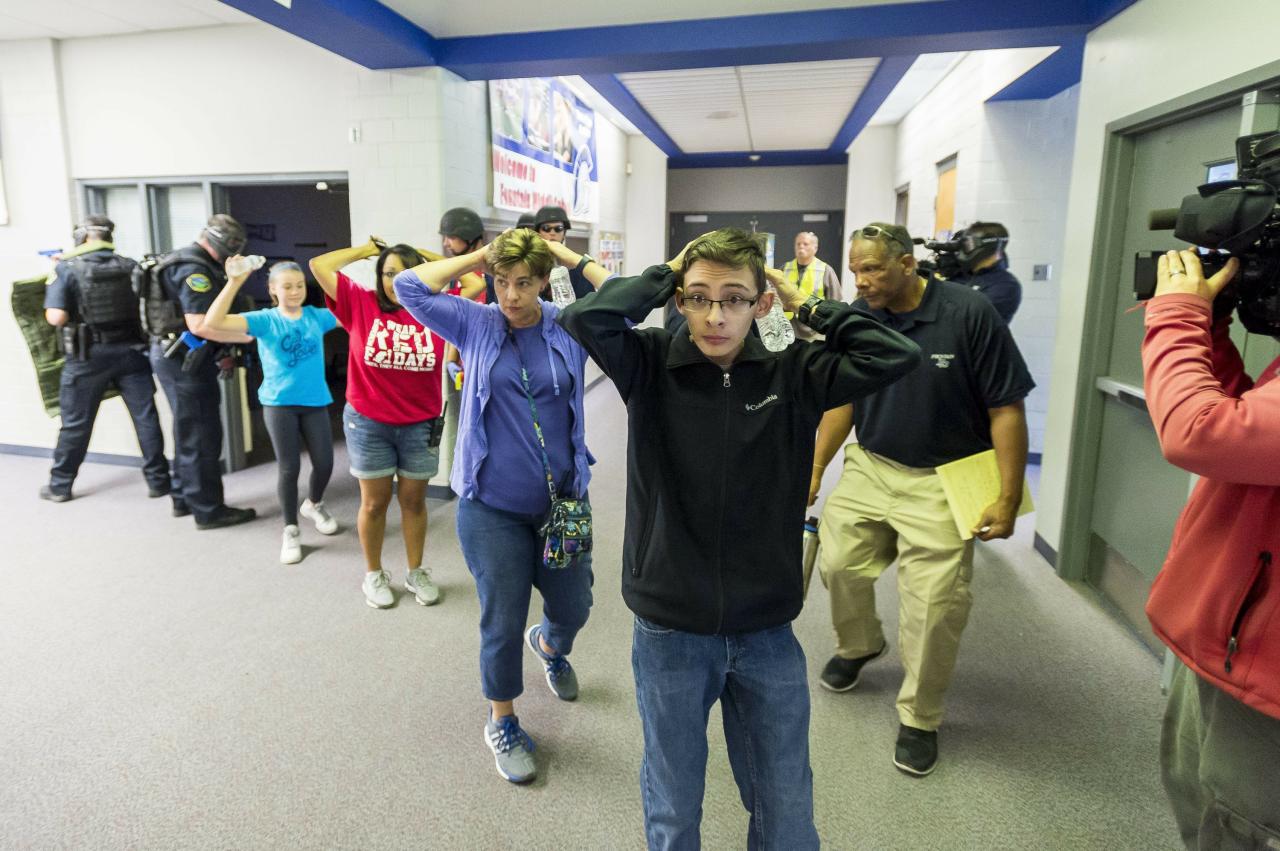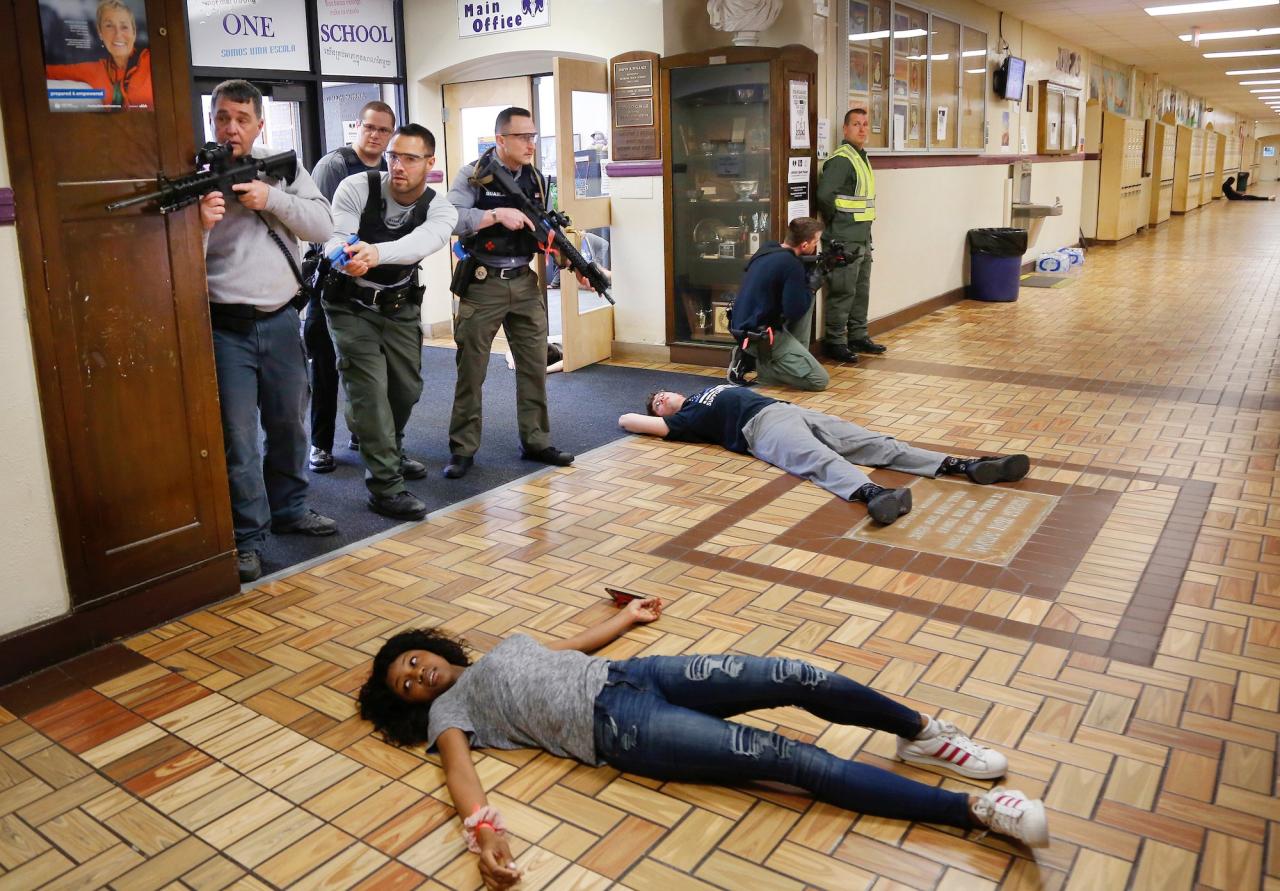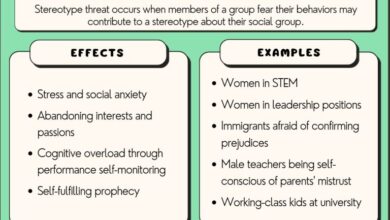
Are Active Shooter Drills Worth It?
Are active shooter drills worth it? This question has become a pressing concern for schools, parents, and communities across the nation. While these drills aim to prepare students and staff for the unthinkable, their effectiveness and potential downsides are hotly debated.
The rise of school shootings has led to a widespread adoption of active shooter drills, with many schools conducting these exercises on a regular basis. The goal is to teach students and staff how to react in the event of a violent attack, but the question remains: are these drills truly effective in preparing individuals for such a traumatic experience?
Or do they inadvertently create more fear and anxiety, potentially even hindering the very safety they aim to promote?
The Purpose and Rationale of Active Shooter Drills
Active shooter drills have become a common practice in schools, workplaces, and other public spaces in response to the increasing threat of gun violence. These drills aim to prepare individuals for potential active shooter situations, providing them with strategies to survive and minimize casualties.
While the intention is to save lives, the psychological and emotional impact of these drills on individuals must be carefully considered. This article will explore the purpose and rationale behind active shooter drills, examining both the intended benefits and potential drawbacks.
The Intended Benefits of Active Shooter Drills
Active shooter drills are intended to provide individuals with the knowledge and skills to react effectively in a crisis situation. They aim to achieve the following:
- Increase awareness of potential threats: Drills help individuals recognize the signs of an active shooter situation and understand the importance of taking immediate action.
- Promote a culture of preparedness: By practicing safety protocols, drills encourage a sense of vigilance and readiness among students, faculty, and staff.
- Develop response strategies: Drills provide individuals with specific actions to take during an active shooter event, such as seeking shelter, evacuating, or taking defensive measures.
- Improve communication and coordination: Drills facilitate communication between individuals and with emergency responders, ensuring a coordinated response in a crisis.
The Psychological and Emotional Impact of Active Shooter Drills
While active shooter drills are intended to be beneficial, they can also have a significant psychological and emotional impact on individuals. The drills can:
- Trigger anxiety and fear: The simulated scenarios can evoke feelings of fear and anxiety, especially for individuals who have experienced trauma or have a history of mental health concerns.
- Create a sense of vulnerability and helplessness: Drills can reinforce a sense of vulnerability and helplessness, as individuals are forced to confront the possibility of a violent attack.
- Desensitize individuals to violence: Repeated exposure to violent scenarios can desensitize individuals to the severity of the threat and make them less likely to take precautions in real-life situations.
- Lead to feelings of stress and fatigue: The constant threat of violence and the need to be prepared can lead to feelings of stress and fatigue, impacting individuals’ overall well-being.
The Effectiveness of Drills in Preparing for Real-World Scenarios
The effectiveness of active shooter drills in preparing individuals for real-world scenarios is a complex issue. Some studies suggest that drills can be effective in improving response times and increasing survival rates. However, others argue that drills can be ineffective or even counterproductive, as they do not adequately prepare individuals for the unpredictable nature of active shooter events.
“It is important to note that active shooter drills are not a substitute for comprehensive security measures and mental health support.”
The effectiveness of drills also depends on factors such as the quality of the training, the level of engagement of participants, and the specific circumstances of the event.
Alternative Approaches to School Safety

Active shooter drills have become a common practice in schools across the country, but there is growing debate about their effectiveness and the potential harm they can cause. While some argue that drills are necessary to prepare students for a potential crisis, others believe they are traumatizing and do not adequately address the root causes of school violence.
As a result, there is a growing interest in exploring alternative approaches to school safety.
The debate about active shooter drills always brings up the question of their effectiveness, and it’s hard to ignore the chilling parallels with the history of abortion access. Reading about the secret network of women who performed abortions before Roe v.
Wade highlights the lengths people went to for basic healthcare. It makes you wonder if, in the face of real danger, we’re better off preparing with drills or fostering a society where such desperate measures are unnecessary.
Alternative approaches to school safety focus on creating a positive and supportive school environment that fosters student well-being and reduces the likelihood of violence. These approaches aim to address the underlying factors that contribute to school violence, such as bullying, mental health issues, and access to firearms.
Mental Health Support and Intervention
Mental health is a crucial aspect of school safety, and providing adequate mental health support can help prevent violence. This includes:
- Increased access to mental health professionals:Schools should have enough counselors, psychologists, and social workers to meet the needs of students.
- Early identification and intervention:Schools should have systems in place to identify students who are at risk of violence or self-harm and provide them with appropriate support.
- Positive behavioral interventions and supports (PBIS):PBIS programs focus on teaching positive behaviors and creating a supportive school climate.
These interventions can help students develop coping skills, manage stress, and build healthy relationships.
Social and Emotional Learning
Social and emotional learning (SEL) programs teach students how to manage their emotions, build healthy relationships, and make responsible decisions. These programs can help students develop empathy, conflict resolution skills, and a sense of community.
- Empathy and perspective-taking:SEL programs can help students understand the perspectives of others and develop empathy for their classmates.
- Conflict resolution skills:Students can learn to resolve conflicts peacefully and respectfully, reducing the likelihood of violence.
- Building positive relationships:SEL programs can help students build strong relationships with their peers and teachers, creating a more supportive and inclusive school environment.
By developing these skills, students can become more resilient and less likely to engage in violence.
School Climate and Culture
A positive school climate is essential for student well-being and safety. This includes:
- Creating a sense of belonging:Students should feel like they are valued members of the school community.
- Promoting respectful interactions:Schools should have clear expectations for respectful behavior and enforce them consistently.
- Addressing bullying and harassment:Schools should have effective policies and procedures for addressing bullying and harassment.
When students feel safe and supported, they are less likely to engage in violence.
Community Partnerships
Schools can work with community organizations to provide support and resources to students and families. This can include:
- Mental health services:Partnerships with community mental health organizations can provide students with access to specialized mental health care.
- After-school programs:After-school programs can provide students with positive activities and opportunities for social interaction.
- Parent education and support:Schools can work with community organizations to provide parents with information and support on parenting, mental health, and school safety.
By working together, schools and communities can create a network of support that can help prevent violence.
Addressing Root Causes
While addressing the immediate needs of students is important, it is also essential to address the underlying causes of school violence. This includes:
- Gun control:Limiting access to firearms can reduce the risk of school shootings.
- Poverty and inequality:Poverty and inequality can contribute to violence by creating stress and hopelessness.
- Racism and discrimination:Racism and discrimination can create a hostile environment that can lead to violence.
Addressing these systemic issues can create a more just and equitable society that is less prone to violence.
Benefits and Limitations of Alternative Approaches
Alternative approaches to school safety have many benefits, including:
- Focus on prevention:Alternative approaches aim to prevent violence by addressing the underlying causes.
- Promote student well-being:These approaches focus on creating a positive and supportive school environment that fosters student well-being.
- Long-term solutions:Alternative approaches provide long-term solutions to school safety by addressing the root causes of violence.
However, alternative approaches also have limitations, including:
- Time and resources:Implementing alternative approaches can require significant time and resources.
- Cultural change:Changing school culture and practices can take time and effort.
- Addressing complex issues:Some of the underlying causes of school violence, such as poverty and inequality, are complex and require systemic solutions.
It is important to note that alternative approaches are not a replacement for traditional safety measures, such as security personnel and emergency plans. Instead, they should be viewed as complementary strategies that can create a more comprehensive and effective approach to school safety.
Effectiveness of Different Safety Measures
Research on the effectiveness of different school safety measures is ongoing. Some studies have found that active shooter drills can have a negative impact on student mental health, while others have found that they can increase preparedness.
Alternative approaches, such as mental health support and SEL programs, have been shown to be effective in reducing violence and improving student well-being. However, more research is needed to determine the long-term effectiveness of these approaches.
It is important to consider the evidence when making decisions about school safety measures. Schools should adopt a comprehensive approach that includes both traditional and alternative measures to create a safe and supportive learning environment for all students.
The Role of Mental Health and Wellbeing

In the wake of the growing concern over active shooter drills in schools, it is crucial to acknowledge the vital role of mental health and well-being in creating a safe and supportive learning environment. Focusing solely on security measures without addressing the underlying mental health needs of students and staff can be counterproductive and even detrimental.
The debate about active shooter drills in schools is complex, and there’s no easy answer. It’s tough to balance safety with the potential psychological impact on students. But it got me thinking about resilience, a trait often discussed in the context of entrepreneurship.
Check out this article on 11 mindset traits of successful entrepreneurs – it highlights how entrepreneurs navigate challenges and uncertainty. Maybe we can learn from their approaches to help students build resilience in the face of real-world threats like active shooter situations.
By prioritizing mental health, schools can foster a culture of resilience, empathy, and positive relationships, which ultimately contributes to a safer and more inclusive school community.
Addressing Mental Health Concerns in Schools
Creating a school environment that prioritizes mental health requires a comprehensive approach. It involves recognizing the diverse mental health needs of students and providing access to appropriate support services. This includes early identification of mental health challenges, promoting mental health awareness, and ensuring access to mental health professionals.
Fostering a Supportive and Inclusive School Environment
A supportive and inclusive school environment is essential for promoting positive mental health and well-being. This involves creating a culture of respect, empathy, and belonging.
- Building positive relationships:Encouraging open communication between students, teachers, and staff is crucial for fostering trust and understanding. This can be achieved through activities like peer mentoring programs, student-led initiatives, and regular check-ins with students.
- Creating a sense of belonging:Inclusive school environments ensure that all students feel valued and respected, regardless of their background, identity, or abilities. This can be achieved through diverse representation in curriculum, extracurricular activities, and school leadership.
- Promoting empathy and compassion:Encouraging students to develop empathy and compassion for themselves and others is crucial for building a supportive and inclusive school environment. This can be achieved through character development programs, service learning opportunities, and fostering a culture of kindness.
Promoting Positive Mental Health and Wellbeing
Schools can actively promote positive mental health and well-being by implementing strategies that address the emotional, social, and physical needs of students.
The debate on whether active shooter drills are worth it is a complex one, and the recent surge in hotel prices adds another layer to the discussion. As major hotel chains like Marriott, Hilton, and Hyatt cite increased operating costs and demand as reasons for their price hikes, why marriott hilton and hyatt say hotel prices are only going up , it begs the question: are we investing enough in resources that can truly make us safer in these changing times?
Ultimately, the answer lies in finding a balance between preparedness and practicality, ensuring we’re not just going through the motions but actively working towards a safer future.
- Mindfulness and relaxation techniques:Incorporating mindfulness practices, such as meditation and deep breathing exercises, can help students manage stress, improve focus, and enhance emotional regulation.
- Physical activity and healthy eating:Promoting physical activity and healthy eating habits can contribute to overall well-being. Schools can offer opportunities for physical activity through PE classes, extracurricular sports, and recess.
- Social-emotional learning programs:Implementing social-emotional learning programs can help students develop self-awareness, empathy, and healthy relationships. These programs can equip students with the skills to navigate challenging situations, manage emotions, and build resilience.
- Access to mental health resources:Ensuring access to mental health professionals, such as school counselors, psychologists, and social workers, is crucial for providing timely and appropriate support to students experiencing mental health challenges.
The Impact on Education and Learning
The implementation of active shooter drills in schools has raised concerns about their potential impact on the educational process. While the primary aim of these drills is to enhance safety, there is a need to carefully consider their effects on students’ learning, academic performance, and overall educational experience.
The Disruption of Educational Activities
Frequent drills can disrupt the flow of regular classroom activities, leading to interruptions in lessons, decreased instructional time, and a sense of disarray in the learning environment. The sudden shift from regular academic tasks to emergency procedures can create anxiety and confusion among students, hindering their ability to focus on learning.
For instance, a study conducted by the National Education Association found that schools with frequent active shooter drills reported a significant decrease in instructional time, with students losing an average of 15 minutes per week due to drill interruptions.
The Role of Law Enforcement and Security: Are Active Shooter Drills Worth It

The role of law enforcement in active shooter incidents is critical, as they are often the first responders to these tragedies. Their actions can have a significant impact on the outcome of the event, determining the number of casualties and the extent of the damage.
The Role of Law Enforcement in Active Shooter Incidents
Law enforcement officers play a crucial role in responding to active shooter incidents, their primary objective being to neutralize the threat and protect innocent lives. Their responsibilities include:
- Rapid Response:Law enforcement officers are trained to respond quickly to active shooter situations, minimizing the time it takes to reach the scene and confront the threat.
- Scene Assessment:Upon arrival, officers must quickly assess the situation, identify the location of the shooter, and determine the best course of action to neutralize the threat.
- Evacuation and Rescue:Officers are responsible for evacuating victims from the danger zone and providing medical assistance to those who have been injured.
- Apprehension of the Shooter:Once the shooter is located, officers must apprehend them and prevent them from causing further harm.
- Securing the Scene:Once the threat has been neutralized, officers must secure the scene to prevent further access and preserve evidence.
Effectiveness of Security Measures
Security measures play a crucial role in deterring and mitigating violence, but their effectiveness depends on several factors, including:
- Physical Security:Physical security measures, such as locked doors, security cameras, and metal detectors, can deter potential attackers and make it more difficult for them to gain access to restricted areas.
- Security Personnel:Trained security personnel can provide an additional layer of protection by monitoring entrances and exits, patrolling the premises, and responding to suspicious activity.
- Emergency Response Plans:Schools and other organizations should have comprehensive emergency response plans in place that Artikel procedures for responding to active shooter incidents, including lockdown procedures, evacuation routes, and communication protocols.
- Mental Health Programs:Addressing mental health concerns among students and staff can help prevent violence by identifying individuals who may be at risk and providing them with the support they need.
Areas for Improvement in Collaboration
There is a need for enhanced collaboration between schools and law enforcement to improve school safety and preparedness for active shooter incidents:
- Regular Communication:Open and regular communication between school administrators and law enforcement is essential to ensure that both parties are aware of potential threats, security vulnerabilities, and the latest best practices for responding to active shooter incidents.
- Joint Training Exercises:Conducting joint training exercises allows school staff and law enforcement officers to practice their response protocols and improve their coordination in a simulated environment.
- Sharing of Information:Law enforcement and schools should share information about potential threats, including individuals who may be at risk or who have made threats of violence.
- Community Engagement:Engaging the community in discussions about school safety and active shooter preparedness can help build trust and encourage collaboration between schools, law enforcement, and parents.
The Importance of Comprehensive Safety Plans
A comprehensive school safety plan is crucial for ensuring the safety and well-being of students, staff, and visitors. It should encompass a multi-faceted approach, addressing various potential threats and vulnerabilities, and outlining strategies for prevention, preparedness, response, and recovery.
Designing a Comprehensive School Safety Plan
A comprehensive school safety plan should be tailored to the specific needs and context of each school. It should include a thorough assessment of potential risks and vulnerabilities, such as natural disasters, active shooter incidents, cyber threats, and bullying. This assessment should involve input from various stakeholders, including administrators, teachers, students, parents, and law enforcement.
- Risk Identification and Assessment:This involves identifying potential threats and vulnerabilities, evaluating their likelihood and impact, and prioritizing them based on their severity.
- Prevention Strategies:This includes implementing measures to prevent incidents from occurring in the first place, such as security measures, access control, and threat assessment programs.
- Preparedness Measures:This involves developing procedures and protocols for responding to various incidents, including drills, training, and communication plans.
- Response Procedures:This Artikels the steps to be taken during an incident, such as evacuation plans, lockdown procedures, and communication protocols.
- Recovery and Mitigation:This addresses the steps to be taken after an incident to restore normalcy, provide support to those affected, and prevent future incidents.
Implementing and Evaluating Safety Measures
Once a comprehensive safety plan is developed, it is essential to implement and evaluate its effectiveness.
- Implementation:This involves putting the plan into action through training, drills, and regular reviews.
- Evaluation:This involves assessing the effectiveness of the plan through feedback from stakeholders, data analysis, and periodic reviews.
Best Practices for Creating and Maintaining Comprehensive Safety Plans, Are active shooter drills worth it
Several best practices can enhance the effectiveness of school safety plans:
- Collaboration and Communication:Involve all stakeholders in the development, implementation, and evaluation of the plan.
- Regular Review and Updates:Review and update the plan regularly to reflect changes in the school environment, technology, and best practices.
- Training and Drills:Conduct regular training and drills to familiarize staff and students with the plan and ensure their preparedness.
- Technology Integration:Incorporate technology into the plan to enhance communication, security, and threat assessment.
- Mental Health and Wellbeing:Address the mental health and wellbeing of students and staff as part of the overall safety plan.
Outcome Summary
Navigating the complex issue of school safety requires a multifaceted approach. While active shooter drills may have a place in a comprehensive safety plan, they should not be the sole strategy. We must prioritize mental health support, foster a sense of community, and create a culture of safety that extends beyond the classroom.
Ultimately, our goal should be to create schools that are not only physically safe but also emotionally and mentally supportive environments where all students can thrive.






